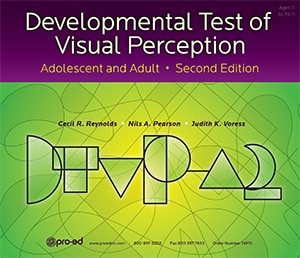Developmental Test of Visual Perception–Adolescent and Adult (DTVP-A:2)
Complete Kit
- Ages 11 through 79 years
- Testing Time 20 - 30 minutes
- Administration Individual
- Scoring Online only
-
Product Code 14915 ( MR #068945 )
* Qualifications required to purchase this item. Click here to complete the qualifications form.
Price $393.00
Contents
-

Developmental Test of Visual Perception–Adolescent and Adult (DTVP-A:2)
DTVP-A:2 Examiner's Manual
$101.00 -

Developmental Test of Visual Perception–Adolescent and Adult (DTVP-A:2)
DTVP-A:2 Picture Book
$101.00 -

Developmental Test of Visual Perception–Adolescent and Adult (DTVP-A:2)
DTVP-A:2 Examiner Record Forms (25)
$71.00 -

Developmental Test of Visual Perception–Adolescent and Adult (DTVP-A:2)
DTVP-A:2 Response Booklets (25)
$79.00 -

Developmental Test of Visual Perception–Adolescent and Adult (DTVP-A:2)
DTVP-A:2 Transparency Scoring Template
$9.00 -

Developmental Test of Visual Perception–Adolescent and Adult (DTVP-A:2)
DTVP-A:2 Online Scoring and Report System
Included with every DTVP-A:2 Examiner Record Forms (25) package
*Not available separately (package component only)
- Eye–Hand Coordination measures the ability to integrate eye–hand movement.
- Form Constancy measures the ability to match two figures that vary in one or more discriminating features (i.e., size, position, or shade).
- Copying measures the ability to recognize the features of a design and to draw it from a model, assessing in large part what is commonly thought of as visual-motor integration skills.
- Visual Closure measures the ability to recognize a stimulus figure when it has been incompletely drawn, which requires good visualization or mental imaging skills, or seeing the gestalt.
- Visual-Motor Search measures the ability to draw lines rapidly connecting numbered shapes in the correct order, engaging good visual search and sequencing skills that are integrated with motor skills.
- Visual-Motor Speed measures the ability to make certain marks in specific designs rapidly and accurately.
- Figure–Ground measures the ability to see specified figures when they are hidden in complex and confusing backgrounds.
-

Developmental Test of Visual Perception–Adolescent and Adult (DTVP-A:2)
DTVP-A:2 Examiner's Manual
$101.00 -

Developmental Test of Visual Perception–Adolescent and Adult (DTVP-A:2)
DTVP-A:2 Picture Book
$101.00 -

Developmental Test of Visual Perception–Adolescent and Adult (DTVP-A:2)
DTVP-A:2 Examiner Record Forms (25)
$71.00 -

Developmental Test of Visual Perception–Adolescent and Adult (DTVP-A:2)
DTVP-A:2 Response Booklets (25)
$79.00 -

Developmental Test of Visual Perception–Adolescent and Adult (DTVP-A:2)
DTVP-A:2 Transparency Scoring Template
$9.00
- Copyright 2021

 Proud to be Canadian
Proud to be Canadian